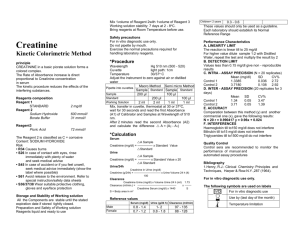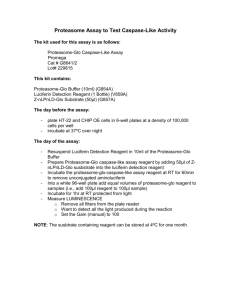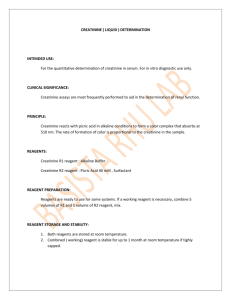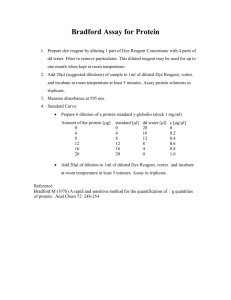Creatinine Assay Kit Protocol | Quantitative Determination
advertisement
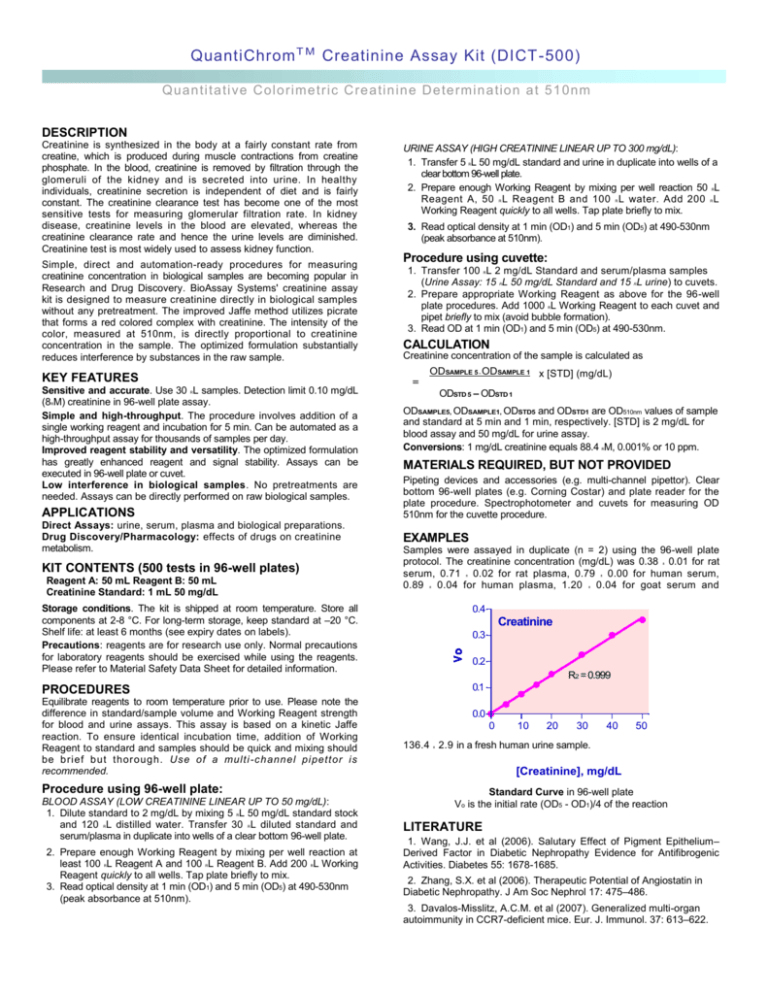
QuantiChrom T M Creatinine Assay Kit (DICT -500) Qu an ti ta ti ve Co lo rime tric C re a tin in e De te rmin a tio n a t 51 0nm DESCRIPTION Creatinine is synthesized in the body at a fairly constant rate from creatine, which is produced during muscle contractions from creatine phosphate. In the blood, creatinine is removed by filtration through the glomeruli of the kidney and is secreted into urine. In healthy individuals, creatinine secretion is independent of diet and is fairly constant. The creatinine clearance test has become one of the most sensitive tests for measuring glomerular filtration rate. In kidney disease, creatinine levels in the blood are elevated, whereas the creatinine clearance rate and hence the urine levels are diminished. Creatinine test is most widely used to assess kidney function. Simple, direct and automation-ready procedures for measuring creatinine concentration in biological samples are becoming popular in Research and Drug Discovery. BioAssay Systems' creatinine assay kit is designed to measure creatinine directly in biological samples without any pretreatment. The improved Jaffe method utilizes picrate that forms a red colored complex with creatinine. The intensity of the color, measured at 510nm, is directly proportional to creatinine concentration in the sample. The optimized formulation substantially reduces interference by substances in the raw sample. URINE ASSAY (HIGH CREATININE LINEAR UP TO 300 mg/dL): 1. Transfer 5 L 50 mg/dL standard and urine in duplicate into wells of a clear bottom 96-well plate. 2. Prepare enough Working Reagent by mixing per well reaction 50 L Reagent A, 50 L Reagent B and 100 L water. Add 200 L Working Reagent quickly to all wells. Tap plate briefly to mix. R R R R R 3. Read optical density at 1 min (OD1) and 5 min (OD5) at 490-530nm (peak absorbance at 510nm). Procedure using cuvette: 1. Transfer 100 L 2 mg/dL Standard and serum/plasma samples (Urine Assay: 15 L 50 mg/dL Standard and 15 L urine) to cuvets. 2. Prepare appropriate Working Reagent as above for the 96-well plate procedures. Add 1000 L Working Reagent to each cuvet and pipet briefly to mix (avoid bubble formation). 3. Read OD at 1 min (OD1) and 5 min (OD5) at 490-530nm. R R R R CALCULATION Creatinine concentration of the sample is calculated as ODSAMPLE 5 ODSAMPLE 1 x [STD] (mg/dL) – KEY FEATURES Sensitive and accurate. Use 30 L samples. Detection limit 0.10 mg/dL (8 M) creatinine in 96-well plate assay. Simple and high-throughput. The procedure involves addition of a single working reagent and incubation for 5 min. Can be automated as a high-throughput assay for thousands of samples per day. Improved reagent stability and versatility. The optimized formulation has greatly enhanced reagent and signal stability. Assays can be executed in 96-well plate or cuvet. Low interference in biological samples. No pretreatments are needed. Assays can be directly performed on raw biological samples. = ODSTD 5 – ODSTD 1 R R APPLICATIONS Direct Assays: urine, serum, plasma and biological preparations. Drug Discovery/Pharmacology: effects of drugs on creatinine metabolism. ODSAMPLE5, ODSAMPLE1, ODSTD5 and ODSTD1 are OD510nm values of sample and standard at 5 min and 1 min, respectively. [STD] is 2 mg/dL for blood assay and 50 mg/dL for urine assay. Conversions: 1 mg/dL creatinine equals 88.4 M, 0.001% or 10 ppm. R MATERIALS REQUIRED, BUT NOT PROVIDED Pipeting devices and accessories (e.g. multi-channel pipettor). Clear bottom 96-well plates (e.g. Corning Costar) and plate reader for the plate procedure. Spectrophotometer and cuvets for measuring OD 510nm for the cuvette procedure. EXAMPLES Samples were assayed in duplicate (n = 2) using the 96-well plate protocol. The creatinine concentration (mg/dL) was 0.38 0.01 for rat serum, 0.71 0.02 for rat plasma, 0.79 0.00 for human serum, 0.89 0.04 for human plasma, 1.20 0.04 for goat serum and ± KIT CONTENTS (500 tests in 96-well plates) ± Reagent A: 50 mL Reagent B: 50 mL Creatinine Standard: 1 mL 50 mg/dL ± ± ± Storage conditions. The kit is shipped at room temperature. Store all components at 2-8 °C. For long-term storage, keep standard at –20 °C. Shelf life: at least 6 months (see expiry dates on labels). Precautions: reagents are for research use only. Normal precautions for laboratory reagents should be exercised while using the reagents. Please refer to Material Safety Data Sheet for detailed information. 0.4 PROCEDURES 0.1 Equilibrate reagents to room temperature prior to use. Please note the difference in standard/sample volume and Working Reagent strength for blood and urine assays. This assay is based on a kinetic Jaffe reaction. To ensure identical incubation time, addition of Working Reagent to standard and samples should be quick and mixing should be b rief b ut thoroug h. Use of a multi -ch ann el pi pettor is recommended. Procedure using 96-well plate: BLOOD ASSAY (LOW CREATININE LINEAR UP TO 50 mg/dL): 1. Dilute standard to 2 mg/dL by mixing 5 L 50 mg/dL standard stock and 120 L distilled water. Transfer 30 L diluted standard and serum/plasma in duplicate into wells of a clear bottom 96-well plate. Creatinine 0.3 0.2 R2 = 0.999 0.0 0 10 20 30 40 50 136.4 2.9 in a fresh human urine sample. ± [Creatinine], mg/dL Standard Curve in 96-well plate Vo is the initial rate (OD5 - OD1)/4 of the reaction R R R 2. Prepare enough Working Reagent by mixing per well reaction at least 100 L Reagent A and 100 L Reagent B. Add 200 L Working Reagent quickly to all wells. Tap plate briefly to mix. 3. Read optical density at 1 min (OD1) and 5 min (OD5) at 490-530nm (peak absorbance at 510nm). R R R LITERATURE 1. Wang, J.J. et al (2006). Salutary Effect of Pigment Epithelium– Derived Factor in Diabetic Nephropathy Evidence for Antifibrogenic Activities. Diabetes 55: 1678-1685. 2. Zhang, S.X. et al (2006). Therapeutic Potential of Angiostatin in Diabetic Nephropathy. J Am Soc Nephrol 17: 475–486. 3. Davalos-Misslitz, A.C.M. et al (2007). Generalized multi-organ autoimmunity in CCR7-deficient mice. Eur. J. Immunol. 37: 613–622.
